|
|
|
Sort Order |
|
|
|
Items / Page
|
|
|
|
|
|
|
| Srl | Item |
| 1 |
ID:
137392


|
|
|
|
|
| Summary/Abstract |
The Tahmineh and Rostam episode, as presented in modern text-critical editions of Ferdowsi's Shahnameh, is compared vis-à-vis both the pre-modern scribal interventions in the manuscript tradition of the poem, as well as two oral presentations of the same episode by traditional storytellers (naqqālān), as preserved in their prompt-books (tumārs) and in recorded performances from the twentieth century. The mise-en-scène, the social circmstances, as well as the expansive nature of such oral performances, are described, and a translation of an oral version of the Rostam and Tahmineh episode is given. The narrative strategies employed to negotiate the intersection of new episodes or contemporary moralistic considerations with the written text of Ferdowsi's Shahnameh are then explored, analyzing the nature, motivations and functions of the scribal and oral interpolations to the Tahmineh episode, and demonstrating how modernizing reinterpretations impart a certain dynamism to the living Shāhnāmeh tradition. The naqqālān are shown to alter the Tahmineh episode to comply with the moral and religious values of their audiences, the requirements of extended narration cycles, and the horizon of expectation of the genre of epic. The article closes with a brief consideration of how moral and religious values apply differentially across various genres (heroic epic, romance, etc.), and how these differing horizons of expectation impact the reinterpretation of the narrative material.
|
|
|
|
|
|
|
|
|
|
|
|
|
|
|
|
| 2 |
ID:
137389
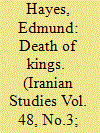

|
|
|
|
|
| Summary/Abstract |
Ferdowsi's Shahnameh was not conceived as a national epic, but it does encapsulate another kind of group identity: it provides context and meaning for the glorious pedigree of the Iranian aristocracy. Ferdowsi himself was a member of the Khorasani dehqān gentry whose collective effort in the tenth century CE was turned towards preserving and reshaping their own history and literary heritage in the terms of the new era. This article analyzes the final section of the Shahnameh, dealing with the reign and death of the last Sasanian king, Yazdegerd III. As such, this section provides crucial clues for the function of the Shahnameh as a means to construct meaning for Ferdowsi's own group in his own time. The description of this crucial moment in history, pivoting between the era of Iranian kingship and the Islamic era, suggested possible modes for interpreting the present. The study reads this section of the Shahnameh with close attention to the use of the word nezhād (“lineage”), which circumscribes the identity of both the aristocrats of Ferdowsi's present, and the kings and heroes of the mythic past. In doing so, the transition between eras appears as a tragedy of nezhād, as the Sasanian dynasty is extinguished, raising permanent existential ambiguities for the entire class of Iranian gentry whose genealogies were associated with it.
|
|
|
|
|
|
|
|
|
|
|
|
|
|
|
|
| 3 |
ID:
137391
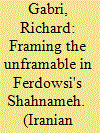

|
|
|
|
|
| Summary/Abstract |
This paper explores the ways in which the Shahnameh thematizes the poet's fraught relationship with language to not only complicate our overall understanding of the epic poem but also our understanding of the language which makes the poem, and the world outside the poem, intelligible. Through a close reading of some of the prologues and epilogues that frame the Shahnameh’s tales, this essay argues that rather than helping us understand how to interpret the epic's morally ambiguous tales, the frames to Ferdowsi's tales, ironically represent a narrator who is in no position to offer us any help. Of course, the poet does give us clues as to why he and consequently we are “helpless” (bichāreh) when it comes to understanding his tales, which, in its own way, can be considered helpful. What seems to hinder understanding at every turn for the poet is, paradoxically, the very language or speech (sakhon/sokhan) that makes understanding possible in the first place.
|
|
|
|
|
|
|
|
|
|
|
|
|
|
|
|
| 4 |
ID:
137390
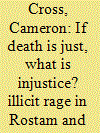

|
|
|
|
|
| Summary/Abstract |
This is a comparative study of anger and narrative control in two tragic stories cast in an epic-heroic register, the “Tale of Rostam and Sohrab” of Ferdowsi's Shahnameh and “The Knight's Tale” of Chaucer's Canterbury Tales. The narrators of both stories are heavily invested in upholding a certain normative interpretation of the events they recount, a fatalistic worldview that justifies itself through the necessarily agnostic optimism that these senseless catastrophes gain meaning when situated within a greater order that is beyond the capacity of man to comprehend. The emotional responses of outrage and grief therefore have no legitimate place in this worldview, and must be submitted to a process of rationalization and violent suppression in order to be kept in check. However, this same process also reveals the underlying aporias of its own normative logic, producing a subtextual counter-narrative that resists and undermines the dominant voice of the text. The resulting fragmentation and narrative collapse provides a fruitful opportunity to investigate how both texts respond to a crucial ontological topic in medieval literature and philosophy: what does it mean to be an autonomous subject within a divinely ordered universe, and how can one distinguish justice from tyranny in a world entirely governed by fate?
|
|
|
|
|
|
|
|
|
|
|
|
|
|
|
|
| 5 |
ID:
137393


|
|
|
|
|
| Summary/Abstract |
This study examines the Jamshid of Ferdowsi's Shahnameh and its later reception, specifically the Islamic refashioning of Jamshid in fourteenth-century Shiraz, as evidenced in the ghazals of Hāfez (d. 1389), and the lyric poetry of Khvāju-ye Kermāni (d. 1352 or 1360), and ʿObeyd-e Zākāni (d. 1371). Hāfez, Khvāju, and ʿObeyd used literary devices such as talmih (allusion) and ubi sunt to both engage with and reshape the past, and this refashioning of the past was employed to legitimize their patrons’ authority to rule from Shiraz. The article culminates in an exploration of the mytho-political dimensions of the conflation of Jamshid with Solomon and the intimate association of this composite figure with Fars in the Ilkhanid and post-Ilkhanid periods. Poetry is treated here as a productive force that both shapes and is shaped by the socio-political circumstances of its composition, performance, and reception. In order to locate the thirteenth- and fourteenth-century reconfiguration of Jamshid within its geo-mythological context, use has been made of the concept of lieu de mémoire as a means through which to unpack the trans-historical cultural impact on Shiraz of the ancient Achaemenid and Sasanian ruins that surround the Islamic city; ruins that have for more than two millennia embedded a sense of proximity to history in the land and peoples of Fars.
|
|
|
|
|
|
|
|
|
|
|
|
|
|
|
|
| 6 |
ID:
137387
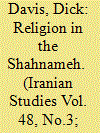

|
|
|
|
|
| Summary/Abstract |
This article discusses the reasons why Ferdowsi does not begin the Shahnameh with the episode of Zoroaster, which he quotes from the version of Daqiqi, but rather with an account of the creation of the world that, in contrast to Islamic historians writing before Ferdowsi, does not attempt to accommodate a Qur'anic view of creation and human history, but neither does he give a cosmology dominated or well informed by Zoroastrian theology. Similarly, Ferdowsi tends to present pre-Islamic Iran as having a consistent religious history, and perhaps avoids beginning with Goshtāsp's conversion to the religion of Zoroaster, as he makes Daqiqi appear to do, in order to minimize the role of religious conflict in Iranian history, again diverging from historians of the Islamic period writing before him. The article also explores the role of God in the Shahnameh and the absence of theodicy.
|
|
|
|
|
|
|
|
|
|
|
|
|
|
|
|
| 7 |
ID:
137388
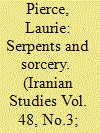

|
|
|
|
|
| Summary/Abstract |
The demonic plays an integral role in the Shahnameh, manifesting itself in countless forms. Early kings and heroes fight demons at every turn, and in one of the most memorable tales in the poem—the story of Zahhāk—Iran itself falls under the rule of demonic forces. But demons are not always physical creatures; we also encounter them as immaterial forces of temptation, distraction, and fate. One of the most fascinating aspects of this multifarious presentation of the demonic is the way it intersects the poem's portrayal of what it means to be human. This article focuses on that intersection, highlighting encounters between human beings and the demonic and arguing that they not only complicate notions of humanity, but also construct and reinforce categories of masculinity and femininity. A close examination of two phenomena at the heart of human–demon contact—serpents and sorcery—reveals how evil is embodied and enacted in highly gendered ways. Male and female characters in the Shahnameh diverge in their abilities to combat the demonic and are lured into wickedness by different means. What emerges from the interplay between human beings and demons and between the categories of masculinity, femininity, and the demonic is a multifaceted and sophisticated portrayal of evil that informs even the simplest and most straightforward tales in Ferdowsi's work.
|
|
|
|
|
|
|
|
|
|
|
|
|
|
|
|
|
|
|
|
|